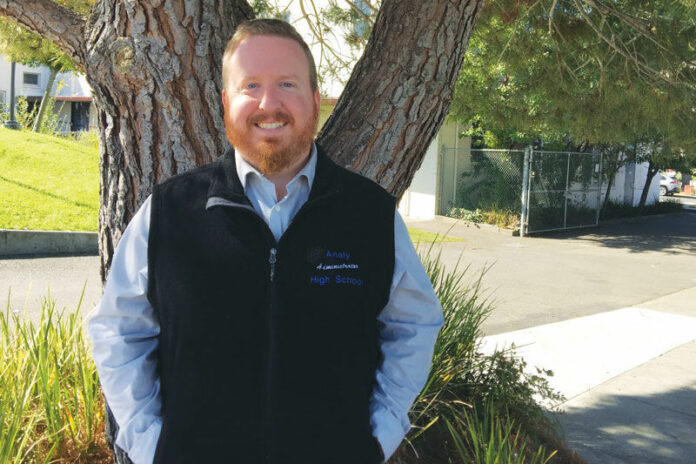In hopes of reducing rising suspension rates, local high schools try a different approach to discipline
West county high schools have recently adopted wide-ranging changes to their discipline policies.
At the last school board meeting of the West Sonoma County Union High School District, Analy Vice Principal Forrest Harper gave a presentation on the new policies.
The first change he announced was that all district high schools — Analy, El Molino and Laguna — now have common disciplinary guidelines.
Until now, he said, some offenses have been dealt with differently at In the past, he said, “one school might do a three-day suspension for a particular offense; one might do a five-day; another might do a one-day suspension or nothing at all. Now we have common guidelines.”
These common guidelines also reflect a shift in the district’s underlying disciplinary philosophy — from one based on punishment to one based on “restorative justice.”
Restorative justice comes to west county
Developed originally for the criminal justice system but increasingly used in schools, restorative justice focuses on mediation and agreement rather than punishment. Under this system, offenders must accept responsibility for the harm they have caused (whether to an individual or to the community) and, in consultation with those they have harmed, they must make restitution.
The primary restorative justice technique is called a restorative circle. In practice, according to Harper, “this means that there is an offender and victim and they get together with a moderator. Then there’s a structured way of working things out together and discussing and coming up with agreements.”
Harper thinks that restorative justice is often misinterpreted as “a weaker form of discipline.”
“Nothing could be farther from the truth,” he said. “This is the main part about restorative practices that is misunderstood. In fact, it’s all about taking responsibility and linking consequences with behavior. A lot of people think, ‘Oh, you just write an apology letter and you just move on,’ but that’s not how it works at all.”
“Kids aren’t getting away with their poor behavior,” he said. “Instead, they’re facing the consequences, and they’re having to reflect and work through their problems, as opposed to just being sent home.
“There’s been many times in my administrative career where I suspended somebody, and as far as they were concerned, they just got a three-day vacation, and then they come back and absolutely nothing has changed.
“There are many more consequences with restorative justice,” he said.
Why the change?
Harper said there were three reasons that WSCUHSD chose to adopt a restorative justice approach.
The first reason is research based.
“There is a lot of research that shows that restorative practices work,” he said, noting that both offenders and victims expressed high levels of satisfaction with restorative justice processes and outcomes, as did their parents.
Harper, who was a vice principal in Santa Rosa for four years before coming to Analy, said that his personal experience using restorative justice techniques with students matched the research.
The second reason for the change is that the California Department of Education (CDE) has recently changed the Education Code to encourage the use of restorative justice practices.
“The state has made it really clear that they want districts moving toward a restorative approach,” Harper said. “As a part of this, they require that before you suspend a student, you need to show that you’ve tried other means of correction.”
Which connects to the third reason: Over the last few years, the West Sonoma County Union High School District has gotten poor marks from the CDE for its rising suspension rates — earning an orange “warning” rating on the California Dashboard, which rates how individual schools perform academically and in several other areas.
Suspension rates have increased at all three west county high schools: Analy has gone from suspending 4.1% of students per year in 2016 to suspending 5.8% in 2018; at El Molino, suspension rates have doubled, going from 4% in 2016 to 8.4% in 2018. The district’s alternative high school, Laguna, saw a doubling in just one year: from 9.4% in 2017 to 18.6% in 2018. (The 2019 numbers won’t be released until November.)
In particular, Harper said, “socio-economically disadvantaged students, Hispanic students and students with disabilities are suspended disproportionately to other students.”
Making the change
Harper said he met with teachers at Analy in mid-September to explain the district’s new discipline policies. For now, he said, restorative justice practices are being put into place at the administration level only — for discipline issues that get elevated to his office. Teachers aren’t expected to use restorative techniques for classroom discipline, though he said some already do.
Taking a restorative justice approach to infractions that would otherwise lead to suspension — like fighting or vaping on campus — should help the district’s suspension numbers. Harper, who started at Analy last year, said he is eager to see the 2019 suspension stats because he suspects his use of restorative justice techniques at Analy will have already delivered better numbers.
The Ed Code actually considers restorative justice to be a form of “suspension diversion.” Although it’s listed on a student’s permanent record, “suspension diversion” doesn’t have the negative connotation that a suspension does, Harper said.
Board members expressed support for the new discipline changes.
“We’ve been asking for this for a longtime,” Board Member Jeanne Fernandes said, echoing the view that many students see a suspension as a vacation.
Board president Diane Landry said she appreciated that restorative justice was a more thoughtful approach to discipline, one that forced students to think through the causes and ramifications of their actions.
“These are teachable moments that will determine what kind of life they lead,” she said. “I’m really excited that we’re on this path. It’s about time, actually.”
58
F
Healdsburg
November 17, 2024








